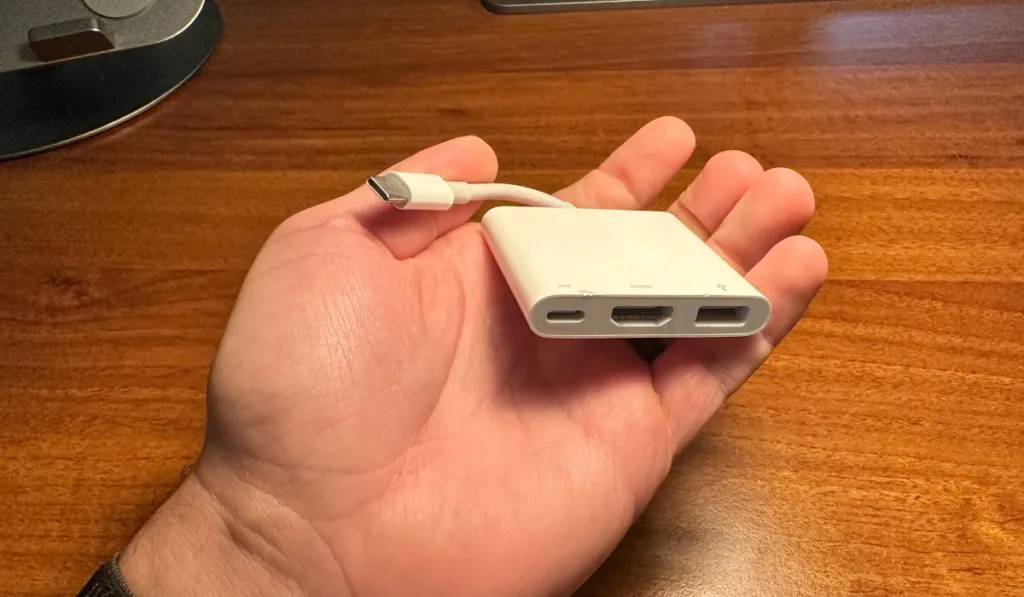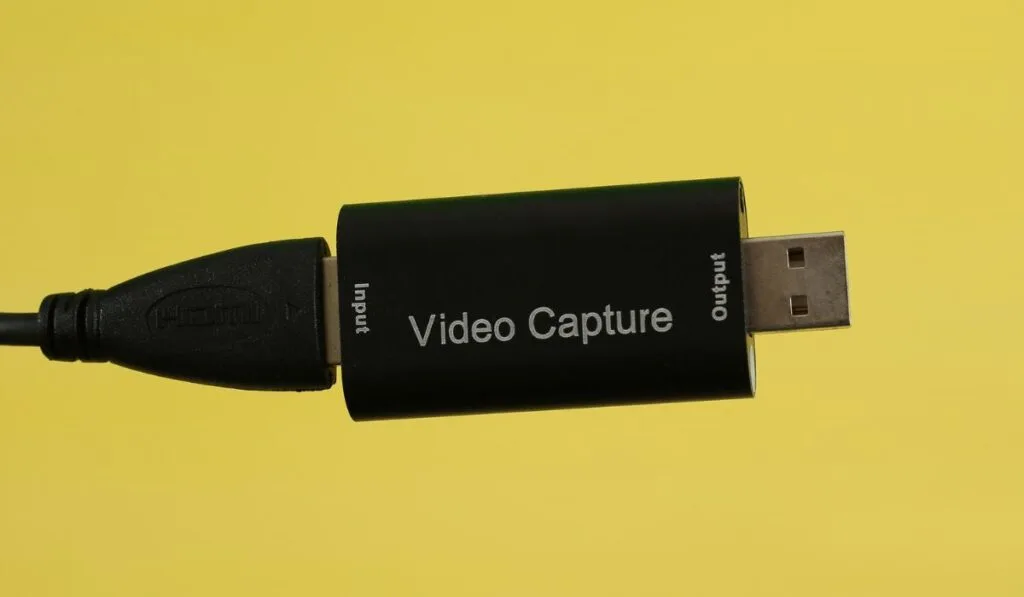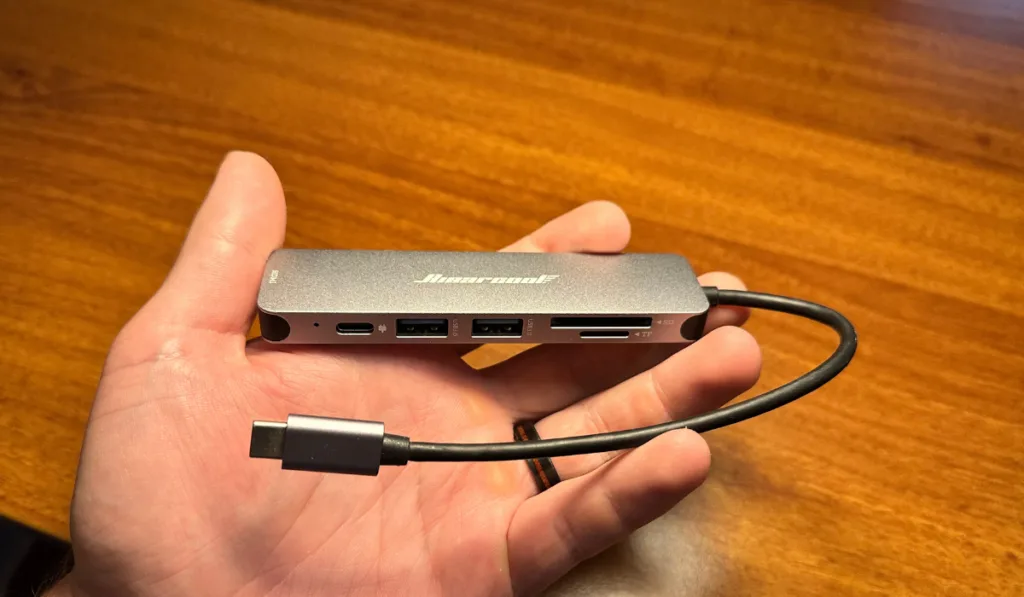If you have found yourself in a situation where you need to convert your HDMI signal into a USB connection, you may have hoped for a simple fix. Unfortunately, things get a little more complicated when playing around with this type of connection. While it may seem like all you would need is a simple adapter, HDMI-to-USB just doesn’t work that way for a couple of reasons.
While you can’t convert an HDMI port to USB, you can use USB-to-HDMI converters to convert signals from common ports like USB and USB-C to HDMI. USB-C hubs typically offer an HDMI port plus more USB ports to use or charge through. To record from an HDMI port, use a Capture Card.
If you don’t know what a capture card is, don’t worry: we’ll talk about that and more in this article. For most people managing an HDMI signal, though, a USB-C hub is the right call. It’s only some niche users like streamers who probably have the problem of the HDMI port itself needing to output somewhere they can record.
Using A USB-C to HDMI Converter

If you have a device with a USB-C port and you want to connect it to a device with an HDMI input, you’ll need a simple USB-C to HDMI converter like this one (on Amazon). A USB-C to HDMI converter allows you to connect your USB-C device, such as a laptop or smartphone, to a device with an HDMI input, such as a monitor or TV.
Here’s how to use a USB-C to HDMI converter:
- Connect the USB-C end of the converter to your device: Plug the USB-C end of the converter into your device’s USB-C port. Make sure that the converter is securely connected.
- Connect the HDMI cable to the converter: Plug one end of the HDMI cable into the HDMI port on the converter. Make sure that the HDMI cable is securely connected.
- Connect the other end of the HDMI cable to your display device: Plug the other end of the HDMI cable into the HDMI port on your display device, such as a monitor or TV.
- Configure your device’s display settings: Depending on your device, you may need to configure your display settings to output video through the HDMI connection. On a Windows PC, for example, you can navigate to the Display settings and select the HDMI output as the primary display. On a Mac, you can use the Displays preferences to select the HDMI output as the primary display.
- Start using your device on the external display: Once your device is connected to the external display, you can start using it as you normally would. You should see your device’s screen mirrored on the external display.
Using a USB-C to HDMI converter is a simple and effective way to connect your USB-C device to an HDMI display. If you only have the one USB-C port, be sure to use a hub option that adds more USB ports for you to use for charging. And if you’re worried because you don’t have a USB-C port, don’t worry, many traditional USB ports can also support a simple HDMI converter (on Amazon).
HDMI-to-USB and Vice Versa – Which Works and Which Doesn’t?
In the past, you would be hard-pressed to find a viable solution to convert HDMI-to-USB. While converting USB-to-HDMI was already a prevalent problem, when using dual monitors, the need for quality HDMI-to-USB just wasn’t large enough. Adapters, like this USB to HDMI Adapter (on Amazon), make it reasonably simple to add an HDMI port to your computer. They allow your computer to communicate with another device through HDMI.
But, what if you reverse those roles? For instance, let’s say you have a video camera you want to use with your computer. It may seem like you can just use the same adapter we listed above, after all, it does have the right connections, doesn’t it?
Unfortunately, it’s not that simple. Unlike USB, HDMI can only work in either an out or in configuration. Using an adapter, like the one above, is useless because it only works with an HDMI output connection.
This is where you’ll need to look into a new solution. Here, the capture cards I mentioned at the top of the article become relevant.
What Are Capture Cards And When Are They Useful?
This is what you use to go from an HDMI signal (like from a game console) and convert it to a digital signal you can record that connects through, yes, ultimately USB. But along that connection sits the capture card
In recent years, capture card technology has improved vastly. Products like the UCEC GAM Live Pro Capture Card (on Amazon) quickly tackle live video transfer over HDMI-to-USB without breaking a sweat.
A capture card can do a couple of really useful things, including the conversion of HDMI to USB in a way that’s free of lag with throughput, and more importantly, they’re incredibly simple to use. It’s worth mentioning though that using a capture card is only relevant if you are trying to transfer a live feed with a computer.
While in this situation, it is possible to use HDMI-to-USB, depending on your needs, it may not be feasible to transfer data over a connection like this. For example, if you are trying to transfer files from one computer to another and all you have is an HDMI out, it won’t work. The two technologies may be similar, but they can’t work in this configuration.
Why Would You Need HDMI-to-USB Conversion?

There are several situations where an HDMI-to-USB connection may be useful. Keep in mind that just because the connection exists doesn’t mean you can get them to work. Here are a couple of situations where this kind of connection just doesn’t work.
- Display with only a USB input – There are devices, like Point of Sale machines, that only seem to take a USB connection. While it may seem possible to connect with an adapter, it won’t work without a computer to process the signal.
- Trying to use an HDMI as a USB – if you are short on ports, you may think you can use an adapter to connect. Since USB and HDMI work on different standards, you won’t be able to use an HDMI port instead of a real USB connection.
If you are working with USB 3.0, you will always run into these issues. They just aren’t compatible enough with each other for them to work in this way. Instead of converting an HDMI-to-USB, if you are short on access ports, try to source a quality USB hub.
If you are trying to use your connection to capture live video, it is possible to use HDMI-to-USB. This may be recording from a camera or capturing an HDMI feed from a gaming console. But, this solution only works if you are also using a computer. The computer is necessary to process the signal, and software is needed to handle that processed signal.
And, a special note here, some audiophiles may have equipment that outputs to HDMI (more discussion in forums here), which could require you to consider one of the most exotic adapters I’ve personally ever seen: the HDMI to toslink audio splitter (on Amazon)!
Capturing Live Video
To process live video through an HDMI-to-USB connection, you will need three different things primarily, including a computer, a quality capture card like the Elgato HD60 (on Amazon), as well as screen recording software like OBS which is probably one of the most popular (and it’s free).
One thing to understand before you start using a capture card is HDCP which we touched on briefly in our article on extending an image to two displays. This is a protection standard that HDMI uses. Essentially, it prevents you from stealing copyrighted work using a capture card. So if you are wanting to capture video from streaming services, you are out of luck.
In this situation, (while trying to convert live video), it is possible to utilize an HDMI-to-USB connection. But it is only within this small purview that it works. For other situations, you will need to find another solution. One of the more common situations is extending the number of USB ports you have through an HDMI out. While this connection just doesn’t work in this way, there are still fixes you can fall back on.
It’s worth noting why these devices are expensive and a tad complicated. As users have pointed out (forum link), USB is actually doing an entirely different type of encoding than HDMI, so, the capture cards have to do the heavy lifting of taking the HDMI signal and coding it into the USB format, which costs computing power and thus requires a small computer and electricity.
How to get More USB Ports if you Need Them

Similar to if you’re trying to get more ethernet ports for your laptop (our guide), If you need extra ports, then there are some simple solutions on the market. Mainly, you will want to find a quality USB hub. A hub will help extend access to multiple types of ports and can be used relatively easily. USB ports can be in short supply. If that is the case, here are a few good USB Docks:
- Wavlink USB 3.0 Docking Station (on Amazon) – This dock uses USB 3.0 to extend the number of USB ports by six and features HDMI out as well. Since the dock uses USB 3.0, it is better suited for PC machines or older Mac computers.
- MOKiN USB C Docking Station (on Amazon) – If you are using a Mac system and only have access to USB type C, this dock is a perfect addition. It adds multiple USB and HDMI ports for your convenience.
It is worth noting that you need to make sure you have USB 3.0 or USB C ports on your computer before purchasing one of these docking stations. Since they need a higher standard to process all those connections, it’s crucial for them to work properly.
Conclusion
Converting an HDMI signal to a USB isn’t that easy. Depending on your situation, it may not even be possible. If you are trying to relay live video data via this connection, then a capture card will help your computer process this information. If you are hoping to extend your port options, then a docking station may be a better solution.
While it may seem like these two cabling technologies are interchangeable, the fact is that they aren’t as similar as they seem. Understanding this can help you assess what you need out of your system. For the most part, the only time you will need this type of connection is to capture live videos like a video game stream or a camera feed. Fortunately, this problem can be solved with a capture card.
